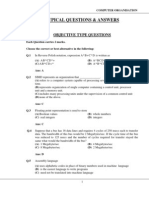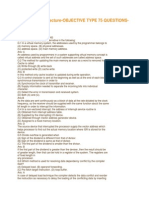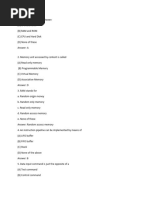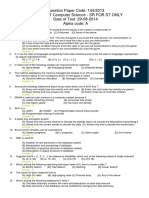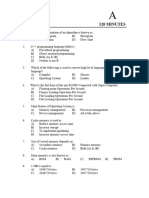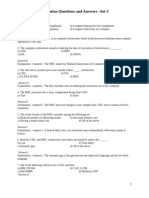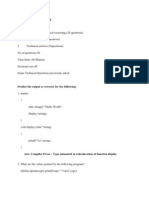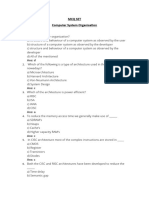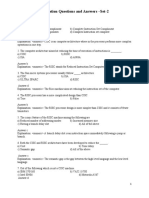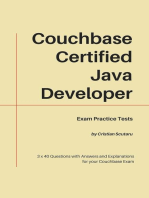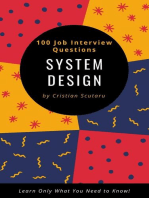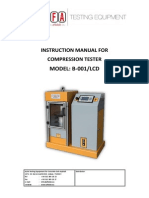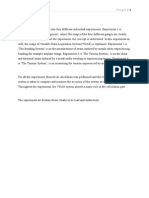0 ratings0% found this document useful (0 votes)
2 viewsComputer Organization Mcq
Computer Organization Mcq
Uploaded by
aakash bhusalThe document consists of multiple-choice questions (MCQs) related to computer organization, covering topics such as Reverse Polish notation, SIMD, floating point representation, bus bandwidth, assembly language, memory characteristics, and more. Each question is followed by the correct answer. The content is designed to test knowledge in computer architecture and organization concepts.
Copyright:
© All Rights Reserved
Available Formats
Download as DOCX, PDF, TXT or read online from Scribd
Computer Organization Mcq
Computer Organization Mcq
Uploaded by
aakash bhusal0 ratings0% found this document useful (0 votes)
2 views5 pagesThe document consists of multiple-choice questions (MCQs) related to computer organization, covering topics such as Reverse Polish notation, SIMD, floating point representation, bus bandwidth, assembly language, memory characteristics, and more. Each question is followed by the correct answer. The content is designed to test knowledge in computer architecture and organization concepts.
Original Description:
MCQ
Copyright
© © All Rights Reserved
Available Formats
DOCX, PDF, TXT or read online from Scribd
Share this document
Did you find this document useful?
Is this content inappropriate?
The document consists of multiple-choice questions (MCQs) related to computer organization, covering topics such as Reverse Polish notation, SIMD, floating point representation, bus bandwidth, assembly language, memory characteristics, and more. Each question is followed by the correct answer. The content is designed to test knowledge in computer architecture and organization concepts.
Copyright:
© All Rights Reserved
Available Formats
Download as DOCX, PDF, TXT or read online from Scribd
Download as docx, pdf, or txt
0 ratings0% found this document useful (0 votes)
2 views5 pagesComputer Organization Mcq
Computer Organization Mcq
Uploaded by
aakash bhusalThe document consists of multiple-choice questions (MCQs) related to computer organization, covering topics such as Reverse Polish notation, SIMD, floating point representation, bus bandwidth, assembly language, memory characteristics, and more. Each question is followed by the correct answer. The content is designed to test knowledge in computer architecture and organization concepts.
Copyright:
© All Rights Reserved
Available Formats
Download as DOCX, PDF, TXT or read online from Scribd
Download as docx, pdf, or txt
You are on page 1of 5
COMPUTER ORGANIZATION MCQ
1. In Reverse Polish notation, expression A*B+C*D is written as
(A) AB*CD*+
(B) A*BCD*+
(C) AB*CD+*
(D) A*B*CD+
Answer: A
2. SIMD represents an organization that ______________.
(A) refers to a computer system capable of processing several programs
at the same time.
(B) represents organization of single computer containing a control unit,
processor unit and a memory unit.
(C) includes many processing units under the supervision of a common
control unit
(D) none of the above.
Answer: C
3. Floating point representation is used to store
(A) Boolean values
(B) whole numbers
(C) real integers
(D) integers
Answer: C
4. Suppose that a bus has 16 data lines and requires 4 cycles of
250 nsecs each to
transfer data. The bandwidth of this bus would be 2
Megabytes/sec. If the cycle time
of the bus was reduced to 125 nsecs and the number of cycles
required for transfer
stayed the same what would the bandwidth of the bus?
(A) 1 Megabyte/sec
(B) 4 Megabytes/sec
(C) 8 Megabytes/sec
(D) 2 Megabytes/sec
Answer: D
5. Assembly language
(A) uses alphabetic codes in place of binary numbers used in machine
language
(B) is the easiest language to write programs
(C) need not be translated into machine language
(D) None of these
Answer: A
6. In computers, subtraction is generally carried out by
(A) 9’s complement
(B) 10’s complement
(C) 1’s complement
(D) 2’s complement
Answer: D
7. The amount of time required to read a block of data from a disk
into memory is
composed of seek time, rotational latency, and transfer time.
Rotational latency
refers to
(A) the time its takes for the platter to make a full rotation
(B) the time it takes for the read-write head to move into position over
the appropriate track
(C) the time it takes for the platter to rotate the correct sector under the
head
(D) none of the above
Answer: A
8. What characteristic of RAM memory makes it not suitable for
permanent storage?
(A) too slow
(B) unreliable
(C) it is volatile
(D) too bulky
Answer: C
9. Computers use addressing mode techniques for
_____________________.
(A) giving programming versatility to the user by providing facilities as
pointers to memory counters for loop control
(B) to reduce no. of bits in the field of instruction
(C) specifying rules for modifying or interpreting address field of the
instruction
(D) All the above
Answer: D
10. The circuit used to store one bit of data is known as
(A) Register
(B) Encoder
(C) Decoder
(D) Flip Flop
Answer: D
11. (2FAOC) 16 is equivalent to
(A) (195 084) 10
(B) (001011111010 0000 1100) 2
(C) Both (A) and (B)
(D) None of these
Answer: B
12. The average time required to reach a storage location in
memory and obtain its contents is called the
(A) seek time
(B) turnaround time
(C) access time
(D) transfer time
Answer: C
13. Which of the following is not a weighted code?
(A) Decimal Number system
(B) Excess 3-cod
(C) Binary number System
(D) None of these
Answer: B
14. The idea of cache memory is based
(A) on the property of locality of reference
(B) on the heuristic 90-10 rule
(C) on the fact that references generally tend to cluster
(D) all of the above
Answer: A
15. Which of the following is lowest in memory hierarchy?
(A) Cache memory
(B) Secondary memory
(C) Registers
(D) RAM
(E) None of these
Ans
Answer: B
16. The addressing mode used in an instruction of the form ADD
X Y, is
(A) Absolute
(B) indirect
(C) index
(D) none of these
Answer: C
17. If memory access takes 20 ns with cache and 110 ns with out
it, then the ratio (cache uses a 10 ns memory) is
(A) 93%
(B) 90%
(C) 88%
(D) 87%
Answer: B
18. In a memory-mapped I/O system, which of the following will
not be there?
(A) LDA
(B) IN
(C) ADD
(D) OUT
Answer: A
19. In a vectored interrupt.
(A) the branch address is assigned to a fixed location in memory.
(B) the interrupting source supplies the branch information to the
processor through an interrupt vector.
(C) the branch address is obtained from a register in the processor
(D) none of the above
Answer: B
20. Von Neumann architecture is
(A) SISD
(B) SIMD
(C) MIMD
(D) MISD
Answer: A
21. The circuit used to store one bit of data is known as
(A) Encoder
(B) OR gate
(C) Flip Flop
(D) Decoder
Answer: C
22. Cache memory acts between
(A) CPU and RAM
(B) RAM and ROM
(C) CPU and Hard Disk
(D) None of these
Answer: A
23. Write Through technique is used in which memory for
updating the data
(A) Virtual memory
(B) Main memory
(C) Auxiliary memory
(D) Cache memory
Answer: D
24. Generally Dynamic RAM is used as main memory in a
computer system as it
(A) Consumes less power
(B) has higher speed
(C) has lower cell density
(D) needs refreshing circuitary
Answer: B
25. In signed-magnitude binary division, if the dividend is (11100)
2 and divisor is (10011) 2 then the result is
(A) (00100) 2
(B) (10100) 2
(C) (11001) 2
(D) (01100) 2
Answer: B
26. Virtual memory consists of
(A) Static RAM
(B) Dynamic RAM
(C) Magnetic memory
(D) None of these
Answer: A
27. In a program using subroutine call instruction, it is necessary
(A) initialise program counter
(B) Clear the accumulator
(C) Reset the microprocessor
(D) Clear the instruction register
Answer: D
28. A Stack-organised Computer uses instruction of
(A) Indirect addressing
(B) Two-addressing
(C) Zero addressing
(D) Index addressing
Answer: C
29. If the main memory is of 8K bytes and the cache memory is of
2K words. It uses associative mapping. Then each word of cache
memory shall be
(A) 11 bits
(B) 21 bits
(C) 16 bits
(D) 20 bits
Answer: C
30 A-Flip Flop can be converted into T-Flip Flop by using
additional logic circuit
(A) n TQD =•
(B) T D =
(C) D = T . Q n
(D) n TQD =?
Answer: D
You might also like
- Basalte Price List EUR March 2022.01Document28 pagesBasalte Price List EUR March 2022.01Stilux Volt100% (1)
- COA Multiple Choice Questions and Answers PDFDocument32 pagesCOA Multiple Choice Questions and Answers PDFAnkita Jape100% (2)
- CSE211 MCQ'sDocument17 pagesCSE211 MCQ'sYash Gupta Maurya100% (1)
- 300+ TOP Computer Organization & Architecture MCQs and AnswersDocument41 pages300+ TOP Computer Organization & Architecture MCQs and AnswersSwapnil100% (2)
- PLC Basic Training (Power Point)Document37 pagesPLC Basic Training (Power Point)Sangeetha Veera100% (1)
- Computer Organization and Architecture PDFDocument63 pagesComputer Organization and Architecture PDFashok psNo ratings yet
- Multiple Choice Questions - Coa: Ans: ADocument8 pagesMultiple Choice Questions - Coa: Ans: ADeepa GoudNo ratings yet
- 7.1. MCQ - Open Book TestDocument24 pages7.1. MCQ - Open Book TestmonishatolenNo ratings yet
- Cs8491 Computer Architecture Unit - 2: Ans: ADocument8 pagesCs8491 Computer Architecture Unit - 2: Ans: AASIF MNo ratings yet
- Computer Organization & Architecture MCQs and AnswersDocument33 pagesComputer Organization & Architecture MCQs and AnswersMs.Sangeetha Priya IT DepartNo ratings yet
- Ugc SolutionDocument174 pagesUgc SolutionNirmal Pandey100% (1)
- Computer Organization and ArchitectureDocument20 pagesComputer Organization and ArchitecturePoovarasanNo ratings yet
- CSE211 MCQ S TXT 426394401 CSE211 MCQ SDocument18 pagesCSE211 MCQ S TXT 426394401 CSE211 MCQ SD StudiosNo ratings yet
- Multiple Choice Questions - Coa: Ans: ADocument8 pagesMultiple Choice Questions - Coa: Ans: A30. Suraj IngaleNo ratings yet
- computer_organisation.1-15Document15 pagescomputer_organisation.1-15facbukiNo ratings yet
- 300+ TOP Computer Organization and Architecture MCQ PDFDocument37 pages300+ TOP Computer Organization and Architecture MCQ PDFSaikumar NemalikantiNo ratings yet
- Computer Organization and Architecture BCA Multiple Choice QuestionsDocument21 pagesComputer Organization and Architecture BCA Multiple Choice QuestionsRazan SthaNo ratings yet
- EC8552 Computer Architecture and Organization MCQ PadeepzDocument9 pagesEC8552 Computer Architecture and Organization MCQ PadeepzNivetha100% (1)
- Interview Questions: 300+ Top Computer Organization & Architecture Mcqs and AnswersDocument55 pagesInterview Questions: 300+ Top Computer Organization & Architecture Mcqs and Answersmohammed100% (1)
- Coa 3 PracticalsDocument9 pagesCoa 3 Practicalsmaingowri4No ratings yet
- Coa Set 1 PracticalsDocument22 pagesCoa Set 1 Practicalsmaingowri4No ratings yet
- Computer Architecture-OBJECTIVE TYPE 75 QUESTIONS-GateDocument8 pagesComputer Architecture-OBJECTIVE TYPE 75 QUESTIONS-GatepranavbommiNo ratings yet
- Computer Organisation and Architecture MCQ Part 1Document5 pagesComputer Organisation and Architecture MCQ Part 1Vimeno Dolie100% (1)
- Coa Digital Tutorial Ques AnsDocument129 pagesCoa Digital Tutorial Ques AnsRajesh TiwaryNo ratings yet
- Ca Q&aDocument129 pagesCa Q&aRavi TejaNo ratings yet
- CoaDocument12 pagesCoariddle2023.ytNo ratings yet
- McqDocument8 pagesMcqstavinadsouzaNo ratings yet
- Paper II Solved For 10 YearsDocument73 pagesPaper II Solved For 10 YearsEs ENo ratings yet
- 10292020214439ECET Computer Science - 2020Document13 pages10292020214439ECET Computer Science - 2020M.hanmandluNo ratings yet
- HSST Computer Science 2013 (SC - ST) PDFDocument7 pagesHSST Computer Science 2013 (SC - ST) PDFSooraj Rajmohan100% (3)
- (A) # Include "Test.h": Unsure AnswersDocument15 pages(A) # Include "Test.h": Unsure AnswersviveshkumarNo ratings yet
- 10066Document13 pages10066visitmajeedNo ratings yet
- Computer Architure Objective Type QuestionsDocument9 pagesComputer Architure Objective Type QuestionsAshish AgarwalNo ratings yet
- Computer Organization and Architecture BCA Multiple Choice QuestionsDocument2 pagesComputer Organization and Architecture BCA Multiple Choice QuestionsInayatUllahNo ratings yet
- Jso 2021 Paper IIIDocument13 pagesJso 2021 Paper IIIduhsaki darngawnNo ratings yet
- 079-2024-ADocument22 pages079-2024-AcsdeptNo ratings yet
- 2012 June UGC NET Paper IIDocument9 pages2012 June UGC NET Paper IIrajasekaranvgNo ratings yet
- CCHMDocument17 pagesCCHMsouvick.1983No ratings yet
- Mca QPDocument13 pagesMca QPAmalNo ratings yet
- SRM TRP Engineering College: Department of Electronics and Communication EngineeringDocument3 pagesSRM TRP Engineering College: Department of Electronics and Communication EngineeringKutty ShivaNo ratings yet
- Computer Architecture MCQDocument8 pagesComputer Architecture MCQVishal ThakurNo ratings yet
- Computer Organization Questions and Answers Set-2Document6 pagesComputer Organization Questions and Answers Set-2dhana lalithaNo ratings yet
- Wipro Selection ProcedureDocument164 pagesWipro Selection Proceduresiva507No ratings yet
- CSO MCQsetDocument6 pagesCSO MCQsetblackcreator420No ratings yet
- Computer Organization Questions and Answers - Set-2Document6 pagesComputer Organization Questions and Answers - Set-2Mouli Mandal100% (2)
- Computer Architecture Unit 1 MCQDocument6 pagesComputer Architecture Unit 1 MCQRaagavi VNo ratings yet
- Question Paper Computer System Architecture (MC121) - January 2005Document14 pagesQuestion Paper Computer System Architecture (MC121) - January 2005amitukumarNo ratings yet
- Microprocessor MCQsDocument67 pagesMicroprocessor MCQsHarsimran50% (2)
- Computer System Architecture Set 1Document10 pagesComputer System Architecture Set 1Emilia KullutweNo ratings yet
- KRL Institute of Technology, Kahuta: CIT-2 Year Subject: Digital & Industrial Electronics Multiple Choice QuestionsDocument7 pagesKRL Institute of Technology, Kahuta: CIT-2 Year Subject: Digital & Industrial Electronics Multiple Choice QuestionsHamza MustafaNo ratings yet
- Final Techquiz QuestionsDocument6 pagesFinal Techquiz QuestionsJayarudranNo ratings yet
- midterm2023امتحان بنيةDocument4 pagesmidterm2023امتحان بنيةAhmed ElkerdawyNo ratings yet
- Microprocessor Question BankDocument67 pagesMicroprocessor Question BankArpit SNo ratings yet
- Introduction to Computer Organization: An Under the Hood Look at Hardware and x86-64 AssemblyFrom EverandIntroduction to Computer Organization: An Under the Hood Look at Hardware and x86-64 AssemblyNo ratings yet
- C Programming for the Pc the Mac and the Arduino Microcontroller SystemFrom EverandC Programming for the Pc the Mac and the Arduino Microcontroller SystemNo ratings yet
- Mathematical and Computational Modeling: With Applications in Natural and Social Sciences, Engineering, and the ArtsFrom EverandMathematical and Computational Modeling: With Applications in Natural and Social Sciences, Engineering, and the ArtsRoderick MelnikNo ratings yet
- Cisco Guidance To Gartner 2019 SDWAN MQDocument3 pagesCisco Guidance To Gartner 2019 SDWAN MQTarun ChakrabartyNo ratings yet
- DPI610 615LP (16jan02)Document4 pagesDPI610 615LP (16jan02)bertan dağıstanlıNo ratings yet
- Passport PVG and VSP4 OverviewDocument77 pagesPassport PVG and VSP4 Overviewhungpm2013No ratings yet
- 3-Modeling 3D EquipmentDocument14 pages3-Modeling 3D EquipmentAdnen Guedria100% (1)
- F2 - Modelling StylesDocument65 pagesF2 - Modelling Styles陈晟音乐族--王子No ratings yet
- Computer Studies Schemes Form 1 1Document28 pagesComputer Studies Schemes Form 1 1ALI MWALIMUNo ratings yet
- Download full Cambridge Technicals Level 3 IT Victoria Ellis ebook all chaptersDocument55 pagesDownload full Cambridge Technicals Level 3 IT Victoria Ellis ebook all chaptersgaetarinksap100% (1)
- Nokia 7610 Supernova RM-354 SM L1&2 v.1.0Document26 pagesNokia 7610 Supernova RM-354 SM L1&2 v.1.0Serena0% (1)
- Seismic Data Processing With Seismic Unix Seg PDFDocument14 pagesSeismic Data Processing With Seismic Unix Seg PDFJorge Orejarena Garcia0% (3)
- Command-Line - ¿Qué VIRT, RES y SHR Significa HTOPDocument2 pagesCommand-Line - ¿Qué VIRT, RES y SHR Significa HTOPKaryn AntunezNo ratings yet
- Delta Ia-Plc Pid An en 20141222Document26 pagesDelta Ia-Plc Pid An en 20141222PrestoneKNo ratings yet
- Omni Flow Computer 3000-6000Document2 pagesOmni Flow Computer 3000-6000syed jeelani ahmed100% (1)
- EPM300 Data SheetDocument1 pageEPM300 Data Sheetbearded79No ratings yet
- Ballast SystemDocument2 pagesBallast SystemArchie MarchieNo ratings yet
- Haltec 2018 PDFDocument59 pagesHaltec 2018 PDFRodney Marin GrlicaNo ratings yet
- Rekap Data Penerima Vaksin Kab. MesujiDocument198 pagesRekap Data Penerima Vaksin Kab. MesujisoniNo ratings yet
- Catalogo U2900 PDFDocument7 pagesCatalogo U2900 PDFdernivaljrNo ratings yet
- Scientech 2502ADocument2 pagesScientech 2502Aashutosh kumarNo ratings yet
- DH-SD6663/6665/6666-H: 18x/26x/36x High Resolution PTZ Dome CameraDocument2 pagesDH-SD6663/6665/6666-H: 18x/26x/36x High Resolution PTZ Dome CameraRobelmNo ratings yet
- A Comparative Study of User Preferences For LaptopDocument50 pagesA Comparative Study of User Preferences For LaptopDhruvNo ratings yet
- B 001Document6 pagesB 001damc321No ratings yet
- Dimensions: V15-W-5M-PURDocument1 pageDimensions: V15-W-5M-PUREric MontesNo ratings yet
- Objective Lab1Document27 pagesObjective Lab1Karthik MuniandyNo ratings yet
- Chapter 2Document60 pagesChapter 2Daniel Halomoan SihalohoNo ratings yet
- 8085 NotesDocument60 pages8085 NotesDavid TalamNo ratings yet
- AX enDocument2 pagesAX enJeanpierre H. AsdikianNo ratings yet
- Street Fighter V Champion Edition PC GameDocument6 pagesStreet Fighter V Champion Edition PC GameE.E KeotiNo ratings yet
- Ifm Connection Technology GBDocument32 pagesIfm Connection Technology GBTùng ThanhNo ratings yet











